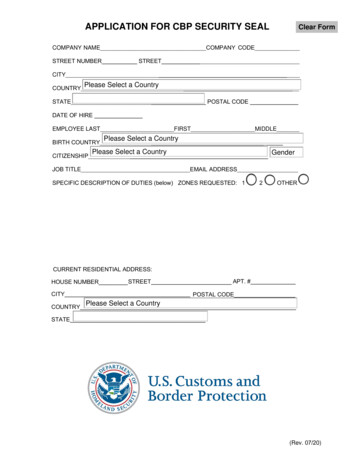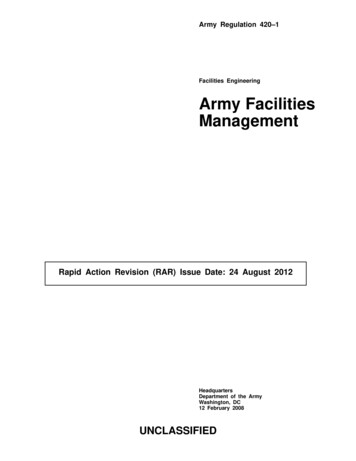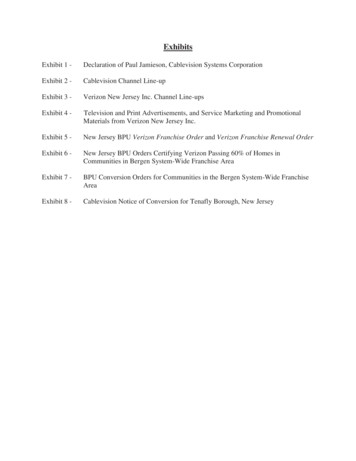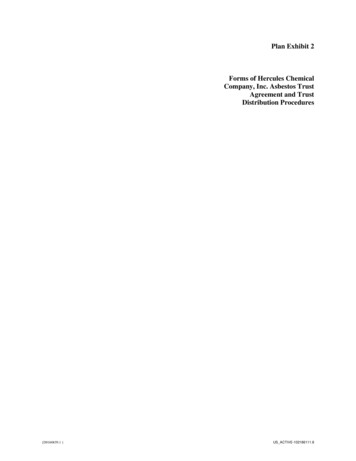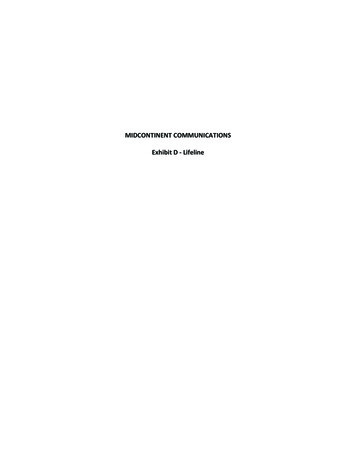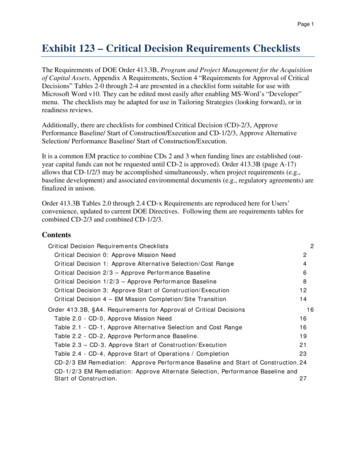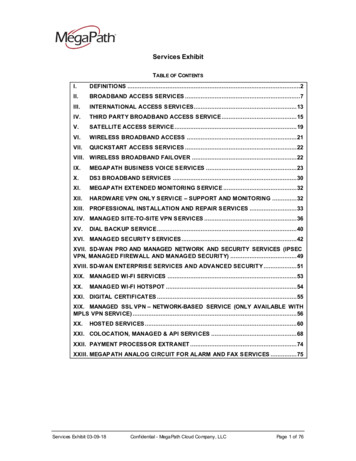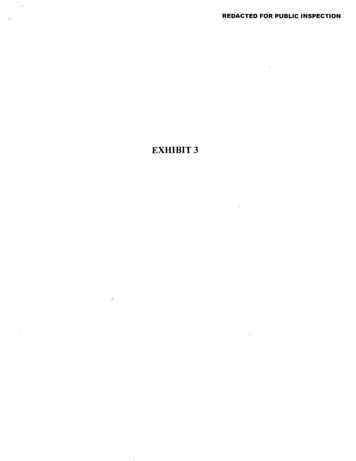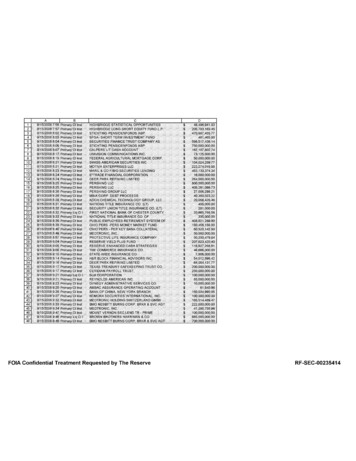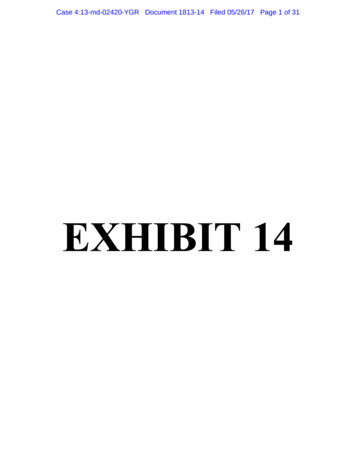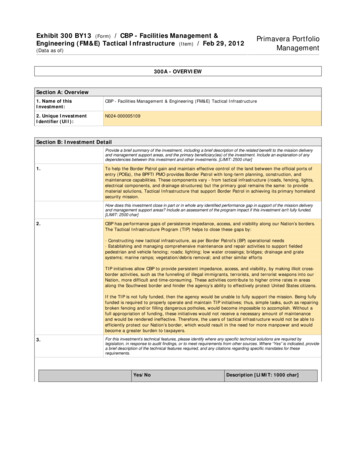
Transcription
Exhibit 300 BY13 (Form) / CBP - Facilities Management &Engineering (FM&E) Tactical Infrastructure (Item) / Feb 29, 2012(Data as of)Primavera PortfolioManagement300A - OVERVIEWSection A: Overview1. Name of thisInvestment:CBP - Facilities Management & Engineering (FM&E) Tactical Infrastructure2. Unique InvestmentIdentifier (UII):N024-000005109Section B: Investment DetailProvide a brief summary of the investment, including a brief description of the related benefit to the mission deliveryand management support areas, and the primary beneficiary(ies) of the investment. Include an explanation of anydependencies between this investment and other investments. [LIMIT: 2500 char]1.To help the Border Patrol gain and maintain effective control of the land between the official ports ofentry (POEs), the BPFTI PMO provides Border Patrol with long-term planning, construction, andmaintenance capabilities. These components vary - from tactical infrastructure (roads, fencing, lights,electrical components, and drainage structures) but the primary goal remains the same: to providematerial solutions, Tactical Infrastructure that support Border Patrol in achieving its primary homelandsecurity mission.How does this investment close in part or in whole any identified performance gap in support of the mission deliveryand management support areas? Include an assessment of the program impact if this investment isn't fully funded.[LIMIT: 2500 char]2.CBP has performance gaps of persistence impedance, access, and visibility along our Nation’s borders.The Tactical Infrastructure Program (TIP) helps to close these gaps by:· Constructing new tactical infrastructure, as per Border Patrol’s (BP) operational needs· Establishing and managing comprehensive maintenance and repair activities to support fieldedpedestrian and vehicle fencing; roads; lighting; low water crossings; bridges; drainage and gratesystems; marine ramps; vegetation/debris removal; and other similar effortsTIP initiatives allow CBP to provide persistent impedance, access, and visibility, by making illicit crossborder activities, such as the funneling of illegal immigrants, terrorists, and terrorist weapons into ourNation, more difficult and time-consuming. These activities contribute to higher crime rates in areasalong the Southwest border and hinder the agency’s ability to effectively protect United States citizens.If the TIP is not fully funded, then the agency would be unable to fully support the mission. Being fullyfunded is required to properly operate and maintain TIP initiatives; thus, simple tasks, such as repairingbroken fencing and/or filling dangerous potholes, would become impossible to accomplish. Without afull appropriation of funding, these initiatives would not receive a necessary amount of maintenanceand would be rendered ineffective. Therefore, the users of tactical infrastructure would not be able toefficiently protect our Nation’s border, which would result in the need for more manpower and wouldbecome a greater burden to taxpayers.3.For this investment’s technical features, please identify where any specific technical solutions are required bylegislation, in response to audit findings, or to meet requirements from other sources. Where “Yes” is indicated, providea brief description of the technical features required, and any citations regarding specific mandates for theserequirements.Yes/NoDescription [LIMIT: 1000 char]
Legislative MandateYesAudit Finding ResolutionNoPublished Agency Strategic PlanYesOther RequirementsNoDHS Appropriations Acts (FY2003-2007)P.L. 109-295- BORDER SECURITYFENCING, INFRASTRUCTURE, ANDTECHNOLOGY: Provides for expenses forcustoms and border protection fencing,infrastructure, and technology, to establisha security barrier along the border of theUnited States of fencing and vehiclebarriers, where practicable, and otherforms of tactical infrastructure andtechnology.Secure our Nation’s borders to protectAmerica from the entry of dangerouspeople and goods and prevent unlawfultrade and travel.AccomplishmentsProvide a list of this investment's accomplishments in the prior year (PY), including projects or usefulcomponents/project segments completed, new functionality added, or operational efficiency achieved. [LIMIT: 1000char]4.The Tactical Infrastructure Program (TIP) achieved significant accomplishments in PY 2011. The TIPmaintained Customs and Border Protection’s current tactical infrastructure (TI) and accomplished thefollowing goals:The TIP operated and maintained the following:-Physical infrastructure: roads; vehicle and pedestrian fences; port of entry barriers; lights; bridges; andtowers for technology and surveillanceThe TIP constructed the following with prior years no-year funds:-0.55 miles of fencing and retaining wall in Brownsville, TX-0.62 miles of fence in Eagle Pass, TX-4.75 miles of road in an area commonly known as 19-Canyon-0.50 miles of pedestrian fence to close several gaps within the Ysleta-Fabens Station Area ofResponsibility (AOR)-2.80 miles of primary fence replacement, construction roads, and wash gates adjacent to city ofNogalesProvide a list of planned accomplishments for current year (CY) and budget year (BY). [LIMIT: 2500 char]5.The Tactical Infrastructure Program (TIP) has an aggressive list of planned accomplishments for CY2012 and BY 2013. The TIP will continue to maintain Customs and Border Protection’s (CBP) currenttactical infrastructure (TI) by accomplishing the following goals:Current Year GoalsThe TIP will operate and maintain the following:-Physical infrastructure: roads; vehicle and pedestrian fences; port of entry barriers; lights; bridges; andtowers for technology and surveillanceThe TIP will construct the following with prior years no-year money:-0.54 miles of fence along the border in Brownsville, TX.-0.86 miles of 2 lane patrol road near the Rio Grande River on land owned by the City of Laredo-0.75 miles of All-Weather Road (AWR) in an area commonly known as 19-Canyon-0.65 miles of primary fence within the El Paso Station Area of Responsibility (AOR)-2.00 miles of road and fence stabilization in Nogales, Arizona-1.04 miles of roadway and a low-water crossing along the international boundary in proximity to theprimary fence segments in Nogales, Arizona-6.1 miles of fence replacement at Douglas Port of Entry (POE)Budget Year Goals
The TIP will:-Continue to sustain the CBP’s tactical infrastructure-Construct Six to eight miles of AWR and low-water crossings and additional north-south access roadswith prior years no-year money-Track tactical infrastructure condition, utilization, and operational costs to increase the efficiency andcost effectiveness of the investment-Highlight funding deficiencies that hinder the execution the investment’s mission6.Provide brief descriptions of out year (BY 1, BY 2, BY 3, BY 4 and beyond as necessary) budget requests for thisinvestment. Briefly describe planned projects and/or useful components proposed, Your justification should addressnew functionality, systems integration, technology refreshes, efficeiencies obtained, and any other enhancements toexisting assets/systems performance or agency operations.Fiscal YearDescription [LIMIT: 500 char]BY 1Continue to sustain the Customs and Border Protection’s tacticalinfrastructure (TI); Track TI condition, utilization, and operationalcosts to increase the efficiency and cost effectiveness of theTactical Infrastructure Program (TIP); Highlight fundingdeficiencies that hinder the execution the investment’s mission;construct new TI and modify existing TI as funding becomesavailableBY 2Continue to sustain the Customs and Border Protection’s tacticalinfrastructure (TI); Track TI condition, utilization, and operationalcosts to increase the efficiency and cost effectiveness of theTactical Infrastructure Program (TIP); Highlight fundingdeficiencies that hinder the execution the investment’s mission;construct new TI and modify existing TI as funding becomesavailableBY 3Continue to sustain the Customs and Border Protection’s tacticalinfrastructure (TI); Track TI condition, utilization, and operationalcosts to increase the efficiency and cost effectiveness of theTactical Infrastructure Program (TIP); Highlight fundingdeficiencies that hinder the execution the investment’s mission;construct new TI and modify existing TI as funding becomesavailableBY 4 and beyondContinue to sustain the Customs and Border Protection’s tacticalinfrastructure (TI); Track TI condition, utilization, and operationalcosts to increase the efficiency and cost effectiveness of theTactical Infrastructure Program (TIP); Highlight fundingdeficiencies that hinder the execution the investment’s mission;construct new TI and modify existing TI as funding becomesavailableProgram ManagementProvide the date of the Charter establishing the required Integrated Program Team (IPT) for this investment. An IPTmust always include, but is not limited to: a qualified fully-dedicated IT program manager, a contract specialist, aninformation technology specialist, a security specialist and a business process owner before OMB will approve thisprogram investment budget. IT Program Manager, Business Process Owner and Contract Specialist must beGovernment Employees.7.Aug 15, 20118.Provide the following 5 required IPT members. IT Program Manager, Business Process Owner and Contract Specialistmust be Government employees.IPT ContactInformationNamePhone NumberExtensionEmail[LIMIT: 250 char][10 digits, 0-9 only][Optional: 6 digits,0-9 only][LIMIT: one email only]
IT ProgramManagerAbel Anderson202-344-2753abel.anderson@dhs.govBusiness ProcessOwnerRobert F Janson202-344-2290Robert.Janson@dhs.govContract SpecialistErin K lInformationTechnologySpecialistSecurity Specialist
300A - SUMMARY OF FUNDINGSection C: Summary of Funding (Budget Authority for Capital Assets) (In Millions)1.Provide the funding summary for this investment by completing the following table. Include funding authority from allsources in millions, and round to three decimal places. Federal personnel costs should be included only in the rowsdesignated “DME Govt. FTE Costs” and “Operations Govt. FTE Costs” and should be excluded where indicated forDME Costs and Operations Costs. Cost levels should be consistent with funding levels in Exhibit 53. For multi-agencyinvestments, this table should include all funding (both managing and partner agency contributions).For years beyond BY 1, please provide your best estimates for planning purposes, understanding that estimates forout-year spending will be less certain than estimates for BY 1 or closer.For lines in the table that ask for changes in your current submission compared to your most recent previoussubmission, please use the President’s Budget as your previous submission. When making comparisons, pleaseensure that you compare same-year-to-same-year (e.g., 2011 v. 2011).Significant changes from the previous submission should be reflected in a the Investment level Alternatives Analysisand is subject to OMB request as discussed in section 300.5.PlanningCosts:PY-1 &EarlierPYCYBYBY 1BY 2BY 3BY 4 &Beyond20102011201220132014201520162017 0.0000.0000.0000.0000.0002,429.800DME . 7.530# of FTEsrep 8.00126.53171.824O&MExcludingGovt otal fromprior yrfinal Pres.Budget( )*
Total chgfrom prioryr finalPres.Budget( )24.615-4.328Total chgfrom prioryr finalPres.Budget(%)19.454-6.026* Source of funding is based on the Exh 53 June 3rd submission and Exhibit 300 February 28th submission.2.While some investments are consistent with a defined life cycle model (i.e., an initial period of development followed bya period of primarily operational spending and an identifiable end point), others represent a collection of ongoingactivities and operations with no known terminal point. In the following table, identify whether or not this investmentuses a defined life cycle model (as defined in OMB Circular A-131) and provide appropriate investment costinformation below.Is this investment consistent with a life cycle model defined in OMB Circular A-131(i.e., an initial period of developmentfollowed by a period of primarily operational spending and an identifiable end point):2.a.NoDescribe why the investment is not consistent with life cycle model management defined in OMB Circular A-131, andexplain how you adapted your alternatives analysis for this investment? (Where an agency uses a cost model otherthan the lifecycle cost model, defined by OMB Circular A-131, responses from 2c to 2h below should reflect thealternative concept.) [LIMIT: 1000 char] (Required if 2.a. is N):2.b.The Tactical Infrastructure Program (TIP) investment is not consistent with life cycle modelmanagement because there is no definitive end date to the investment. The TIP builds and maintainstactical infrastructure (TI) for the Office of Border Patrol (OBP), which will be done in perpetuity so longas funding is available and the mission is strategically necessary.The Analysis of Alternatives (AA) is conducted on a project level, which is consistent with life cyclemodel management because each project has a definitive start and end date. Each TIP project conductsa Site AA to determine the best site for the proposed facility. The AA methodology ensures that OBPmaximizes its resources and minimizes taxpayer burden by allowing project managers to select the mostcost-effective sites for projects.Provide information on what cost model this investment is using and how costs are captured for what years [LIMIT:1000 char] (Required if 2.a. is N):2.c.The Tactical Infrastructure Program (TIP) accrues costs from individual tactical infrastructure (TI)projects as they are obligated. TIP projects utilize firm fixed price contracts, which realize costs whencertain production benchmarks are met. The project costs are rolled up to the programmatic level in theyear they obligated.What year did this investment start (use year—i.e., PY-1 2010) (Required if 2.a. is Y):2.d.What year will this investment end (use year—i.e., BY 5 2018) (Required if 2.a. is Y):2.e.Estimated Total DME cost (including planning) for the investment life cycle or other cost model (excluding FTE):2.f.2,490.648Estimated Total O&M cost the investment life cycle or other cost model (excluding FTE):2.g.622.500Estimated total Govt. FTE Cost for the investment life cycle or other cost model:2.h.27.530If the funding levels have changed from the FY 2012 President’s Budget request for PY or CY, briefly explain thosechanges [LIMIT: 500 char]:3a.Funding levels have not changed from the FY 2012 President's Budget request.
300A - ACQUISITION/CONTRACT STRATEGYSection D: Acquisition/Contract Strategy1. Complete or update the table to display all prime contracts (or task orders) awarded or open solicitations for this investment (sub-award details is notrequired). Contracts and/or task orders that have “Ended” should not be included in the table. Contracts in open solicitation should provide estimated data forall fields (for “Total Contract Value” the estimated base contract costs and all anticipated option years). Data definitions can be found atwww.usaspending.gov/learn#a2.For specifics, please see notes 1 and 2 below the table.# Active? Contract Contracting y IDInstrument Contract/Exemption? Delivery AgencyIDIdentifierVehicleID[LIMIT: 250(IDV)char]PIID(requiredif part ofan IDV)1ActiveAwarded2100W912BV-08D-2025 -07D-2024 DY01NoNO7014NOGFR-11R-00013ActivePre-award 2100PostsolicitationMod#4 ed2100W912PP-110060NoNO7014Sole Sourceto 8a5ActiveAwarded2100W912BV-07D-2040, -08D-2032, -08D-2011, -08D-2012, -08D-2026, CQ02NoNO7014# AlternateEVMUltimateType ofIs theEffectiveActual orExtentShortContractorFinancing Required Contract Contract/Task contract adateexpected End Competed description ofNameValueOrderPerformanceDate ofservices or( M)(Pricing)BasedContract/Taskproduct to Firm Fixed Price NoApr 12,2011May 8, 2012NotCompetedNGL D-5a rdstabilization W912BV-08-D2025 CQ01Army CorpsofEngineers2NANo11.020Firm Fixed Price NoFeb 28,2011Jul 1, 2011Full andNGL fence replOpen- W912BV-07Competition D-2024 DY01Army CorpsofEngineers3NANo0.140Firm Fixed Price NoJun 23,2011Dec 11, 2011NotCompetedRGV O-17 move Army Corpsfence/west rail - ofW912BV-08-D- Engineers2032 DZ02
4NANo0.070Firm Fixed Price NoApr 4,2011Jun 11, 2011NotCompetedMAR L-1 pipeArmy Corpsrepair/extension of- W912PP-11Engineers00605NANo4.730Firm Fixed Price NoNov 10,2010Jun 24, 2011Full andM-2C (PF225) OpenW912BV-07-DCompetition 2040, DZ02Army CorpsofEngineers6NANo4.510Firm Fixed Price NoJun 22,2011Oct 24, 2011Full andO-20 (PF225)OpenW912BV-08-DCompetition 2032, DZ02Army CorpsofEngineers7NANo6.140Firm Fixed Price NoOct 18,2010Sep 9, 2011Full andO-21A (PF225)OpenW912BV-08-DCompetition 2011, DZ04Army CorpsofEngineers8NANo10.570Firm Fixed Price NoDec 13,2010May 16, 2012Full andRGV GatesOpenW912BV-08-DCompetition 2012, DZ06Army CorpsofEngineers9NANo0.980Firm Fixed Price NoJun 3,2008Aug 28, 2011NotCompetedArmy CorpsofEngineersDouglas DitchNote 1: Assuming the PIID or IDV PIID match with USAspending.gov, these data elements will be automatically populated for awarded IT acquisitionsNote 2: Assumingthe PIID, IDV PIID, or Solicitation number match with USAspending.gov or FedBizOpps (fbo.gov) this data will be auto populated forawarded and pre-award, post-solicitation IT acquisitions.Earned Value ExplanationIf earned value is not required or will not be a contract requirement for any of the contracts or task orders above,explain why: [LIMIT: 2500 char]2.This mission of the Tactical Infrastructure Program (TIP) is to build and maintain tactical infrastructure(TI), such as fielded pedestrian and vehicle fencing; roads; lighting; low water crossings; and bridges,to support Border Patrol (BP) agents and enhance border security. To accomplish this mission, theBorder Patrol Facilities and Tactical Infrastructure Program Management Office (BPFTI PMO) contractswith individual vendors through the U.S. Army Corps of Engineers (USACE) to construct TI. Whenimplementing TIP initiatives, as part of its risk-mitigation strategy, BPFTI PMO issues a firm fixed pricecontract for each initiative. Since each TI project is governed by a firm fixed price contract, the vendorsare only compensated upon the completion of specific milestones. These milestones are measuredagainst contractor-provided monthly progress reports of construction schedules. The monthly reportsare uploaded into an Integrated Master Schedule (IMS), which the BPFTI PMO uses to calculateschedule variances. The BPFTI PMO utilizes the IMS schedule variances along with the FacilitiesInfrastructure Tracking Tool (FITT) to identify projects that are behind schedule and to determine thecorrective action. The firm fixed price contract eliminates the risk of cost overruns and transfers the costburden of project delays to the vendor. The firm fixed price contract, along w
Primavera Portfolio Management. 300A - OVERVIEW ; Section A: Overview . 1. Name of this Investment: . and management support areas, and the primary beneficiary(ies) of the investment.
